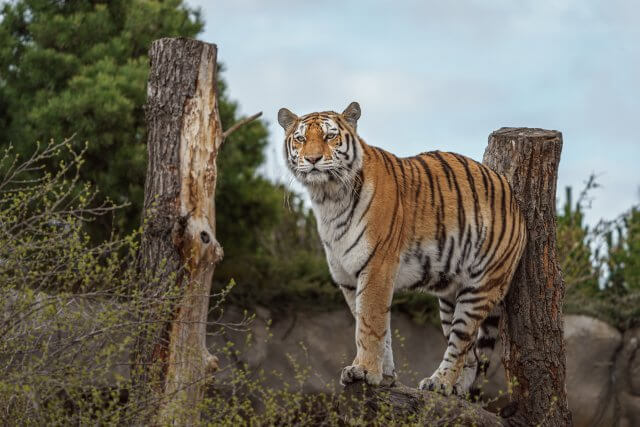Preserving Tigers: Conserving the Majestic Wild Species
Preserving Tigers:
Tigers are one of the most iconic and majestic wild species on our planet. With their striking appearance and powerful presence, they have captured the hearts and imaginations of people all over the world. However, these magnificent creatures are facing numerous threats to their survival, including habitat loss, poaching, and human-wildlife conflict. As a result, there has been a growing effort to preserve and conserve tigers in their natural habitats. In this essay, we will explore the importance of preserving tigers and the various conservation efforts being undertaken to protect these magnificent animals.
The Importance of Habitat Preservation for Tiger Conservation
Tigers are one of the most iconic and majestic wild species on our planet. With their striking orange and black stripes, powerful build, and fierce demeanor, they have captured the hearts and imaginations of people all over the world. However, these magnificent creatures are facing a grave threat to their survival – habitat loss. As human populations continue to grow and expand, the natural habitats of tigers are being destroyed at an alarming rate. In this article, we will explore the importance of habitat preservation for tiger conservation and why it is crucial for the survival of this endangered species.
Habitat loss is the primary threat to tigers, with deforestation being the main cause. As human populations expand, forests are being cleared for agriculture, infrastructure development, and other human activities. This results in the fragmentation of tiger habitats, making it difficult for them to find suitable prey and mates. It also increases their chances of coming into conflict with humans, leading to their persecution and death. Moreover, deforestation also contributes to climate change, which has a direct impact on the survival of tigers. As temperatures rise and weather patterns become more unpredictable, it becomes challenging for tigers to adapt and survive in their changing habitats.
Preserving tigers habitats is crucial for their survival for several reasons. Firstly, tigers are apex predators, meaning they play a vital role in maintaining the balance of their ecosystems. By keeping prey populations in check, they prevent overgrazing and maintain the health of the forests. This, in turn, benefits other species that share the same habitat as tigers. Secondly, tigers require large areas of undisturbed forests to thrive. They are solitary animals and need a vast territory to hunt, mate, and raise their young. By preserving their habitats, we are ensuring that they have enough space to carry out these essential activities.
Preserving Tigers: One of the most effective ways to preserve tiger habitats is through protected areas such as national parks and wildlife reserves. These areas are designated and managed specifically for the conservation of wildlife, including tigers. They provide a safe haven for tigers to live and breed without the threat of human interference. However, it is not enough to just create protected areas; they must also be well-managed and adequately funded. This includes regular monitoring of tiger populations, anti-poaching efforts, and community involvement in conservation efforts. When local communities are involved in conservation, they become stakeholders in protecting tigers and their habitats.
Preserving Tigers: Another crucial aspect of habitat preserving Tigers conservation is the protection of corridors. These are strips of land that connect different tiger habitats, allowing them to move freely between them. Corridors are essential for maintaining genetic diversity among tiger populations, as it allows for the exchange of genes between different groups. It also helps prevent inbreeding, which can lead to genetic defects and reduced fitness. Moreover, corridors also provide tigers with access to new territories, reducing the chances of conflict with humans.
In addition to protected areas and corridors, sustainable land-use practices are also crucial for Preserving Tigers habitats. This includes promoting sustainable agriculture and forestry practices that do not harm tiger habitats. It also involves working with local communities to find alternative livelihoods that do not rely on exploiting natural resources. By providing economic incentives for conservation, we can reduce the pressure on tiger habitats and ensure their long-term survival.
Preserving Tigers: Habitats is crucial for the conservation of this majestic wild species. It not only benefits tigers but also has a positive impact on the health of their ecosystems and the well-being of local communities. It is a complex and challenging task, but with proper management and community involvement, we can ensure that tigers continue to roam the forests for generations to come. As responsible citizens of this planet, it is our duty to protect and preserve these magnificent creatures and their habitats.
Preserving Tigers: Effective Strategies for Combating Illegal Wildlife Trade and Protecting Tigers
Preserving Tigers are one of the most iconic and majestic wild species on our planet. With their striking stripes and powerful presence, they have captured the hearts and imaginations of people all over the world. However, these magnificent creatures are facing a grave threat – illegal wildlife trade. The demand for tiger parts, such as their bones, skin, and other body parts, has led to a sharp decline in their population. In fact, it is estimated that there are only around 3,900 tigers left in the wild, a drastic decrease from the 100,000 tigers that roamed the earth just a century ago.
The illegal wildlife trade is a multi-billion dollar industry, and tigers are one of its most sought-after commodities. This trade is driven by the belief in traditional medicine that tiger parts have healing properties, as well as the demand for tiger skins and other body parts as status symbols. This has led to the poaching of tigers, which involves killing them for their body parts, and the trafficking of these parts to various parts of the world.
Preserving Tigers: To combat this illegal trade and protect tigers, effective strategies need to be implemented. One of the most crucial steps is to address the demand for tiger parts. This can be achieved through education and awareness campaigns, particularly in countries where the demand for tiger parts is high. These campaigns can highlight the negative impact of the illegal wildlife trade on tigers and the environment, as well as promote alternative and sustainable forms of traditional medicine.
Another important strategy is to strengthen law enforcement and increase penalties for those involved in the illegal wildlife trade. This includes not only poachers and traffickers but also those who buy and sell tiger parts. By making the consequences of participating in this trade more severe, it can act as a deterrent and reduce the demand for tiger parts.
In addition to addressing the demand, it is also crucial to protect tigers in their natural habitats. This can be achieved through the establishment of protected areas and the implementation of anti-poaching measures. Protected areas provide a safe haven for tigers to thrive and reproduce, while anti-poaching measures such as increased patrols and the use of technology like drones can help prevent poaching.
Collaboration and cooperation between governments, conservation organizations, and local communities are also essential in the fight against illegal wildlife trade. This includes sharing information and intelligence, as well as working together to develop and implement effective conservation strategies. Local communities, in particular, play a crucial role as they are often the first line of defense against poachers. By involving them in conservation efforts and providing alternative livelihoods, they can become valuable allies in protecting tigers.
Furthermore, it is important to address the issue of corruption, which often enables the illegal wildlife trade to thrive. Governments must take a strong stance against corruption and ensure that those involved in the illegal trade are brought to justice. This can be achieved through the implementation of strict laws and regulations, as well as the training of law enforcement officials to identify and combat corruption.
Preserving Tigers: The illegal wildlife trade poses a significant threat to tigers and their survival. To effectively combat this trade and protect these majestic creatures, a multi-faceted approach is needed. This includes addressing the demand for tiger parts, strengthening law enforcement, protecting their natural habitats, and promoting collaboration and cooperation between various stakeholders. By implementing these strategies, we can work towards preserving tigers and ensuring that they continue to roam our planet for generations to come.
Conclusion
In conclusion, Preserving Tigers is crucial for the conservation of one of the most majestic and iconic wild species on our planet. Tigers play a vital role in maintaining the balance of their ecosystems and their loss would have a significant impact on the environment. By conserving tigers, we are not only protecting a beautiful and powerful animal, but also ensuring the survival of many other species that rely on them. It is our responsibility to take action and implement effective conservation efforts to ensure the long-term survival of tigers and preserve their place in the natural world. Let us work together to protect these magnificent creatures and secure a future where tigers continue to roam freely in the wild.
Read More About Tigers From Wikipedia







